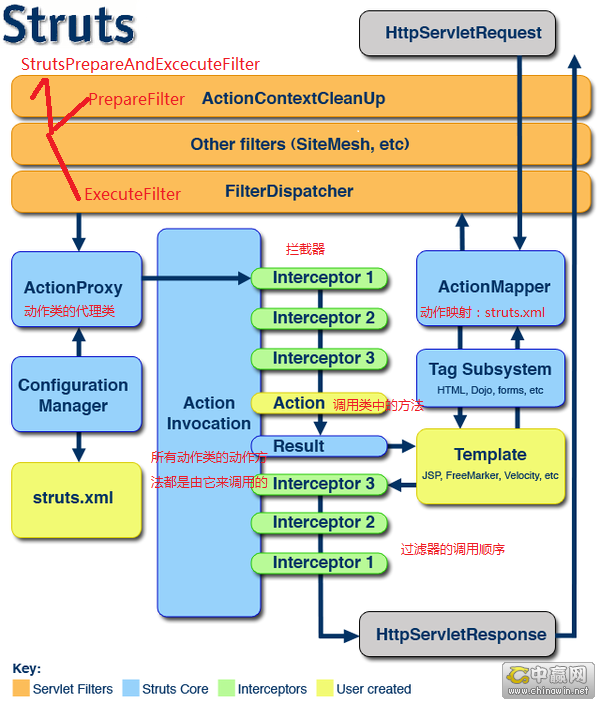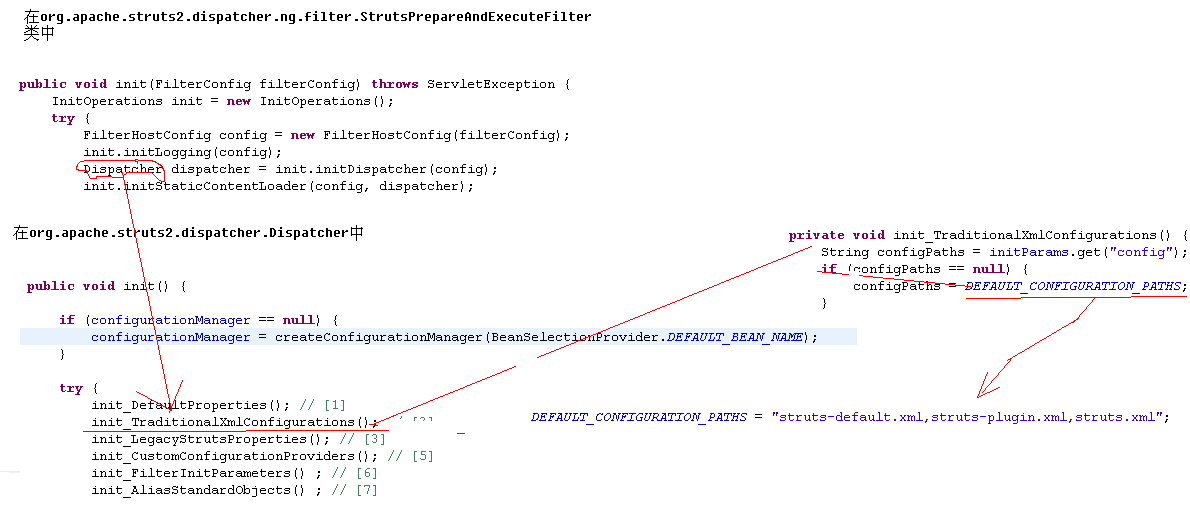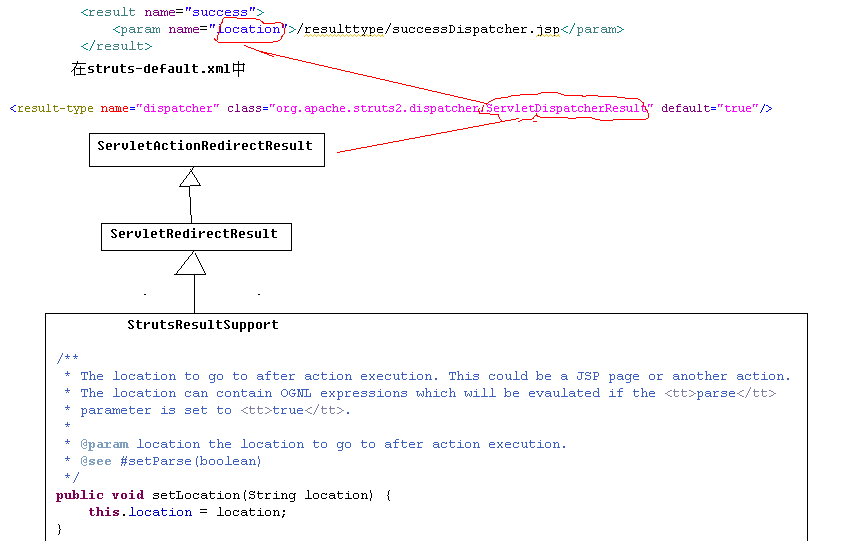【struts2基础】配置详解
一、struts2工作原理(网友总结,千遍一律)
1 客户端初始化一个指向Servlet容器(例如Tomcat)的请求
2 这个请求经过一系列的过滤器(Filter)(这些过滤器中有一个叫做ActionContextCleanUp的可选过滤器,这个过滤器对于Struts2和其他框架的集成很有帮助,例如:SiteMesh Plugin)
3 接着FilterDispatcher被调用,FilterDispatcher询问ActionMapper来决定这个请是否需要调用某个Action
4 如果ActionMapper决定需要调用某个Action,FilterDispatcher把请求的处理交给ActionProxy
5 ActionProxy通过Configuration Manager询问框架的配置文件,找到需要调用的Action类
6 ActionProxy创建一个ActionInvocation的实例。
7 ActionInvocation实例使用命名模式来调用,在调用Action的过程前后,涉及到相关拦截器(Intercepter)的调用。
8 一旦Action执行完毕,ActionInvocation负责根据struts.xml中的配置找到对应的返回结果。返回结果通常是(但不总是,也可 能是另外的一个Action链)一个需要被表示的JSP或者FreeMarker的模版。在表示的过程中可以使用Struts2 框架中继承的标签。在这个过程中需要涉及到ActionMapper
在上述过程中所有的对象(Action,Results,Interceptors,等)都是通过ObjectFactory来创建的。

二、struts2基本配置
2.1 struts.xml配置文件详解
<struts>
<!-- 开发模式下使用,打印更多详细错误信息 -->
<constant name="struts.devMode" value="true" /> <!-- 国际化 -->
<constant name="struts.i18n.encoding" value="UTF-8"/> <!-- 允许ognl访问静态方法 -->
<constant name="struts.ognl.allowStaticMethodAccess" value="true" /> <!--
该属性指定需要struts2处理的请求后缀,默认值是action,即,所有匹配*.action的请求
都由struts2处理,如果用户需要指定多个请求后缀,则多个后缀之间以英文逗号","隔开
-->
<constant name="struts.action.extension" value="action"/> <!-- 设置浏览器是否缓存静态内容,默认值为true(生产环境下使用),开发阶段最好关闭 -->
<constant name="struts.serve.static.browserCache" value="false"/> <!-- 当struts的配置文件修改后,系统是否自动重新加载该文件,默认值false:不重新加载 -->
<constant name="struts.configuration.xml.reload" value="true"/> <!-- 默认的视图主题 -->
<constant name="struts.ui.theme" value="simple"/> <!-- 与spring集成时,指定由spring负责管理action对象的创建 -->
<constant name="struts.objectFactory" value="spring"/> <!-- 该属性设置struts2是否支持动态方法调用,默认值true:支持 -->
<constant name="struts.enable.DynamicMethodInvocation" value="false"/> <!-- 上传文件的大小限制 -->
<constant name="struts.multipart.maxSize" value="10701096"/> <!-- 引入文件 -->
<include file="cn/qjc/action/login/login.xml"></include>
<include file="cn/qjc/action/demo/demo01.xml"></include>
<include file="cn/qjc/interceptor/interceptor.xml"></include>
</struts>
struts2配置文件加载顺序
a、default.properties:struts2-core**.jar org.apache.struts包中(程序员只能看)
b、struts-default.xml:struts2-core**.jar中(程序员只能看)
c、struts-plugin.xml:在插件的jar包中(程序员只能看)
d、struts.xml:在应用的构建路径顶端。自己定义的Struts配置文件(推荐)
e、struts.properties:在应用的构建路径顶端。程序员可以编写(不推荐)
f、web.xml:配置过滤器时,指定参数。程序员可以编写(不推荐)
特别注意:顺序是固定的。后面的配置会覆盖前面的同名配置信息。
加载struts.xml过程

说明:
1、 在启动的时候加载了三个配置文件 struts-default.xml、struts-plugin.xml、struts.xml
2、 如果这三个文件有相同的项,后面覆盖前面的。
3、 struts.xml文件必须放在src下才能找到。
2.2 package元素
意义:分模块开发
属性:
name:必须的。配置文件中要唯一。就是一个名字。
extends:指定父包。会把父包中的配置内容继承下来。一般需要直接或间接的继承一个叫做“struts-default”的包(在struts-default.xml配置文件中)。
如果不继承该包,那么Struts2中的核心功能将无法使用。
abstract:是否是抽象包。没有任何action子元素的package可以声明为抽象包。
namespace:指定名称空间。一般以”/”开头。该包中的动作访问路径:namesapce+动作名称。如果namespace=””,这是默认名称空间,和不写该属性是一样的。
2.3 action配置
作用:定义一个动作。
属性:
name:必须的。动作名称。用户用于发起请求。在包中要唯一。
class:指定动作类的全名。框架会通过反射机制实例化。默认是:com.opensymphony.xwork2.ActionSupport。
method:指定动作类中的动作方法。框架会执行该方法。默认是execute()。
<!-- 配置全局视图:访问动作时没有局部视图,则找全局视图 -->
<package name="default" extends="struts-default" abstract="true">
<global-results>
<result name="success">/WEB-INF/login/success.jsp</result>
</global-results>
</package> <package name="login" namespace="/user" extends="default">
<action name="login" class="cn.qjc.action.login.Login" method="login">
<!-- type默认dispatcher 表示请求转发 -->
<result name="success" type="dispatcher">/WEB-INF/login/success.jsp</result>
<result name="error">/WEB-INF/login/error.jsp</result>
</action>
</package>
三、动作类(Action类)
3.1 编写动作类的三种方式:
a、POJO(Plain Old Java Object)普通的JavaBean。
/**
* 编写动作类方式一:普通javaBean
* @author qjc
*/
public class Demo1Action {
public String seyHello(){
System.out.println("动作类执行了");
return "success";
}
}
b、实现com.opensymphony.xwork2.Action接口
/**
* 编写动作类方式二:实现Aaction接口
* @author qjc
*/
public class Demo2Action implements Action{ @Override
public String execute() throws Exception {
System.out.println("动作类执行了");
return SUCCESS;
}
}
c、继承com.opensymphony.xwork2.ActionSupport(推荐)
意义:提供了一些基本的功能。比如验证和国际化消息提示等。
/**
* 编写动作类方式三:继承ActionSupport类
* @author qjc
*/
public class Demo3Action extends ActionSupport{ }
3.2 ActionSupport用法
在struts框架中,准备了一个ActionSupport类,源码分析:
代码段一:
public class ActionSupport implements Action, Validateable, ValidationAware, TextProvider, LocaleProvider, Serializable {
代码段二:
/**
* A default implementation that does nothing an returns "success".
* <p/> ActionSupport是一个默认的Action实现,但是只返回了一个字符串success
* Subclasses should override this method to provide their business logic.
* <p/>子类需要重新覆盖整个方法,在这个方法中写相应的逻辑
* See also {@link com.opensymphony.xwork2.Action#execute()}.
*
* @return returns {@link #SUCCESS}
* @throws Exception can be thrown by subclasses.
*/
public String execute() throws Exception {
return SUCCESS;
}
代码段三:
public static final String SUCCESS = "success";
说明:
1、代码段一说明了ActionSupport也实现了Action接口(以前写的类实现了Action接口)
2、代码段二说明如果程序员写自己的action继承了ActionSupport,需要重新覆盖execute方法即可。
3、这个方法默认的返回的是success;
所以在配置文件中也可以这样写:
<action name="actionSupprotAction">
<result name="success">/baseconfig/successActionSupport.jsp</result>
</action>
可以看到action标签中没有class属性,在struts-default.xml中,
<default-class-ref class="com.opensymphony.xwork2.ActionSupport" />
说明:
如果在action标签中没有写class属性。那么根据上述的配置文件,struts2会启用ActionSupport这个类。所以action标签中的class属性可以不写。
四、结果类型
1、 每个action方法都返回一个String类型的值,struts一次请求返回什么值是由这个值确定的。
2、 在配置文件中,每一个action元素的配置都必须有result元素,每一个result对应一个action的返回值。
3、 Result有两个属性:
name:结果的名字,和action中的返回值一样,默认值为success;
type:响应结果类型,默认值为dispatcher.
在struts-default.xml文件中,如下面所示
<result-types>
<result-type name="chain" class="com.opensymphony.xwork2.ActionChainResult"/>
<result-type name="dispatcher" class="org.apache.struts2.dispatcher.ServletDispatcherResult" default="true"/>
<result-type name="freemarker" class="org.apache.struts2.views.freemarker.FreemarkerResult"/>
<result-type name="httpheader" class="org.apache.struts2.dispatcher.HttpHeaderResult"/>
<result-type name="redirect" class="org.apache.struts2.dispatcher.ServletRedirectResult"/>
<result-type name="redirectAction" class="org.apache.struts2.dispatcher.ServletActionRedirectResult"/>
<result-type name="stream" class="org.apache.struts2.dispatcher.StreamResult"/>
<result-type name="velocity" class="org.apache.struts2.dispatcher.VelocityResult"/>
<result-type name="xslt" class="org.apache.struts2.views.xslt.XSLTResult"/>
<result-type name="plainText"
说明:
1、 从上述可以看出总共10种类型
2、 默认类型为ServletDispatcherResult即转发。
3、 结果类型可以是这10种结果类型的任意一种。
4.1 dispatcher类型:
dispatcher类型是最常用的结果类型,也是struts框架默认的结果类型。
在配置文件中,可以有两种写法:
第一种写法:
<result name="success">/resulttype/successDispatcher.jsp</result>
第二种写法:
<result name="success">
<param name="location">/resulttype/successDispatcher.jsp</param>
</result>
下面的图说明了location的来历:

4.2 redirect类型:
这种结果类型与dispatcher类型相对,dispatcher结果类型是将请求forwsrd(转发)到指定的JSP资源;而redirect结果类型,则意味着将请求redirect(重定向)到指定的视图资源。
redirect与dispatcher差别主要是转发和重定向的差别:重定向会丢失所有的请求参数、请求属性,当然也丢失Action处理结果。
注意:
使用redirect类型的结果时,不能重定向到/WEB-INF/路径下任何资源,因为重定向相当于重新发送请求,而Web应用的WEB-INF/路径是受保护的。
4.3 redirectAction类型:
这种结果类型与redirect类型非常相似,一样是重新生成一个全新请求,但与redirect区别在于:redirectAction使用ActionMapperFactory提供的ActionMapper来重定向求情。
即:把结果类型重新定向到action。
可以接受两种参数
a) actionName: action的名字
b) namespace:命名空间
第一种方式
<result name="success" type="redirectAction">resulttype/redirectactionAction.action</result>
第二种方式
<result name="success" type="redirectAction">
<!--
actionName:
请求的action的路径
namespace:
如果不写,默认就是请求的action的路径,如果写,路径将被重新赋值
-->
<param name="actionName">
resulttype/redirectactionAction.action
</param>
</result>
4.4 其他类型
freemarker:用于转发到另外一个freemarker模板。(页面静态化)
velocity:用于转发到另外一个velocity模板。
httpheader:用于输出http协议的消息头。
xslt:XML有关的样式
redirect:用于重定向到另外一个JSP页面。
redirectAction:用于重定向到另外一个动作。
stream:用于文件下载(日后再讲。文件上传和下载)
plainText:以纯文本的形式展现页面。输出源码。
4.5 自定义类型
自定义结果类型步骤

以随机验证码图片为例
a、编写一个类,直接或间接实现com.opensymphony.xwork2.Result接口。一般继承org.apache.struts2.dispatcher.StrutsResultSupport类
/**
* 使用自定义结果集加载验证码
* @author qjc
*/
public class Demo02 extends StrutsResultSupport{
private int width=120;
private int height=80;
private int codeCount=4;
private int lineCount=100;
@Override
protected void doExecute(String finalLocation, ActionInvocation invocation)
throws Exception {
//输出结果即可 ValidateCode vc =
new ValidateCode(width, height, codeCount, lineCount);
BufferedImage image = vc.getBuffImg(); //输出即可
HttpServletResponse response = ServletActionContext.getResponse();
ImageIO.write(image, "jpeg", response.getOutputStream()); }
//此处省略getter and setter ...
}
b、声明结果类型,然后才能使用
<!--
自定义结果集
-->
<package name="p3" extends="struts-default">
<result-types>
<!-- 结果类型定义 -->
<result-type name="captcha" class="cn.qjc.action.demo.Demo02"></result-type>
</result-types>
</package>
c、使用
<action name="captcha">
<!--使用自定义结果类型:captcha -->
<result name="success" type="captcha">
<param name="width">200</param>
</result>
</action>
页面编写
<body>
<form action="${pageContext.request.contextPath }/user/login.action">
用户名:<input name="username"><br>
密 码:<input type="password" name="password"><br>
验证码:<input name="code" size="4">
<img src="${pageContext.request.contextPath}/captcha.action"><br>
<input type="submit" value="登录">
</form>
</body>
五、Action原型模式
在servlet中,一个servlet只有一个对象,也就是说servlet是单例模式。如果把一个集合写在servlet属性中,则要考虑线程安全的问题。
但是在struts2的框架中,并不存在这种情况,action是多例的。也就是说struts2中的action,只要访问一次就要实例化一个对象。这样就不存在线程安全的问题。这也是struts2框架的一个好处。
可以写一个类,如下:
package cn.qjc.struts2.action.moreinstance;
import com.opensymphony.xwork2.ActionSupport;
@SuppressWarnings("serial")
public class MoreInstanceAction extends ActionSupport{
public MoreInstanceAction(){
System.out.println("create new action");
}
public String execute(){
System.out.println("more instance action");
return SUCCESS;
}
}
配置文件为:
<struts>
<package name="moreinstance" namespace="/moreinstance">
<action name="moreinstanceAction"
class="cn.qjc.struts2.action.moreinstance.MoreInstanceAction">
</action>
</package>
</struts>
请求两次http://localhost:8080/struts2/moreinstance/moreinstanceAction.action路径,如果构造函数中的”create new action”输出两次,说明创建了两次对象。
【struts2基础】配置详解的更多相关文章
- struts2基本配置详解2
接上篇struts2基本配置详解,还有一些配置没有讲到,下面将继续. struts.xml <package name="com.amos.web.action" names ...
- Java进阶知识04 Struts2的基础配置详解
1.Struts2的原理/流程步骤 简单的理解: 1.客户端发送一个request请求,Tomcat服务器接收到的请求经过web.xml配置文件去处理,进入struts2的核心过滤器,从而进入s ...
- Java进阶知识15 Spring的基础配置详解
1.SSH各个的职责 Struts2:是web框架(管理jsp.action.actionform等).Hibernate:是ORM框架,处于持久层.Spring:是一个容器框架,用于配置bean,并 ...
- Struts2 XML配置详解
struts官网下载地址:http://struts.apache.org/ 1. 深入Struts2的配置文件 本部分主要介绍struts.xml的常用配置. 1.1. 包配置: S ...
- Java进阶知识03 Hibernate的基础配置详解
1.Hibernate的原理/流程步骤 1.通过Configuration().configure(); 读取并解析hibernate.cfg.xml配置文件,并创建一个configuration对象 ...
- Struts2基本配置详解
Struts2配置文件加载顺序 struts2 配置文件由核心控制器加载 StrutsPrepareAndExecuteFilter (预处理,执行过滤) init_DefaultProperties ...
- Struts2(三)配置详解
一.概述 Struts2提供了多种可选的配置文件形式. 其中,struts-default.xml和default.properties是框架级别的配置文件,这两个文件在Struts的核心JAR包中, ...
- nginx 基础配置详解
#本文只对nginx的最基本配置项做一些解释,对于配置文件拆分管理,更详细的集群健康检查的几种方式,检查策略等在此不做详细解释了. #运行用户user nobody;#启动进程,通常设置成和cpu的数 ...
- Hibernate游记——装备篇《一》(基础配置详解)
Hibernate配置文件可以有两种格式,一种是 hibernate.properties ,另一种是 hibernate.cfg.xml 后者稍微方便一些,当增加hbm映射文件的时候,可以直接在 h ...
- HAProxy的基础配置详解
HAProxy是高性能的企业级负载均衡调度器,同时支持四层TCP和七层HTTP协议的负载均衡调度,以及支持基于cookie的持久性,支持正则表达式及web状态统计.自动故障切换等优点,因此广泛被应 ...
随机推荐
- 【刷题】BZOJ 3653 谈笑风生
Description 设T 为一棵有根树,我们做如下的定义: ? 设a和b为T 中的两个不同节点.如果a是b的祖先,那么称"a比b不知道 高明到哪里去了". ? 设a 和 b 为 ...
- ubuntu 16.04换源 网易、搜狐、阿里云
如何更改源可以在软件更新中选择源 使用如下命令更改(修改前先备份): [html] view plain copy print?sudo cp /etc/apt/source.list /etc/ap ...
- dp乱写1:状态压缩dp(状压dp)炮兵阵地
https://www.luogu.org/problem/show?pid=2704 题意: 炮兵在地图上的摆放位子只能在平地('P') 炮兵可以攻击上下左右各两格的格子: 而高原('H')上炮兵能 ...
- 【bzoj3196】 Tyvj1730—二逼平衡树
http://www.lydsy.com/JudgeOnline/problem.php?id=3196 (题目链接) 题意 1.查询k在区间内的排名:2.查询区间内排名为k的值:3.修改某一位值上的 ...
- NOI Linux的安装说明以及使用指南
安装 本人的安装环境为Win10. 1. 首先从官网上下载一个CCF官方提供的Noi linux虚拟机以及安装文档 传送门 2. 然后,安装一个VMware Workstation 14 Pro,这里 ...
- E. The Supersonic Rocket Codeforces Round #502 (in memory of Leopoldo Taravilse, Div. 1 + Div. 2)
http://codeforces.com/contest/1017/problem/E 凸包模板+kmp #include <cstdio> #include <cstdlib&g ...
- SSM搭建Spring单元测试环境
原文链接:https://jingyan.baidu.com/article/93f9803f5a97a4e0e46f55c8.html SSM搭建Spring单元测试环境
- (转)Python中的模块循环导入问题
本文转自: https://wiki.woodpecker.org.cn/moin/MiscItems/2008-11-25 问题 cleven <shenglipang@gmail.com&g ...
- 小贾漫谈——Java反射
一.Class的API 二.测试使用的JavaBean class Admin{ //字段 public String userName; public String pwd; private int ...
- kubeadm部署Kubernetes集群
Preface 通过kubeadm管理工具部署Kubernetes集群,相对离线包的二进制部署集群方式而言,更为简单与便捷.以下为个人学习总结: 两者区别在于前者部署方式使得大部分集群组件(Kube- ...
